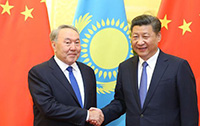Sino-LatAm community of common destiny based on equality, mutual trust
(Xinhua) Updated: 2015-05-27 15:22MEXICO CITY -- Chinese Premier Li Keqiang's four-nation Latin America tour reflected both sides' sincerity in building a community of common destiny based on equality and mutual trust.
Li's visit came at a time of weak global economic recovery, when both China and Latin America are faced with the pressure of economic transformation.
Li wrapped up his visit on Tuesday after a host of agreements were signed to promote production capacity cooperation and cultural exchanges.
The agreements, inked during the premier's visit to Brazil, Colombia, Peru and Chile, clearly show the willingness of both China and Latin America to strengthen their mutually beneficial cooperation.
Brazilian President Dilma Rousseff said last week that Brazil and China built up their bilateral strategic cooperative relationship on a basis of equality and mutual trust. The truth is that China and Latin America are marching toward building a Sino-Latin American community of common destiny based on the same principle.
From a historical perspective, the development of Latin America, a land rich in natural resources and energy, has been hindered by the low level of industrialization, and lack of funding, technology and infrastructure.
At present, Latin American countries affected by a weaker global market and falling prices of commodities are grappling with a great pressure from international trade, inflation and poor macroeconomic situation.
Under these circumstances, the Chinese premier's Latin America tour has taken on greater importance. Li's visit has been marked by cooperation in production capacity, infrastructure and equipment manufacturing, bringing together Latin America's needs and China's advantages.
In the long run, Latin America doesn't want to limit itself to the status as a "world supplier" of raw materials. China, likewise, no longer wants to be "the world's factory" for cheap goods.
The trade structure for run-of-the-mill industrial products and raw materials doesn't support sustainable development, so both sides need to join hands in pursuing industrial modernization and a transformation of their economic growth models.
- Premier Li meets ECLAC executive secretary in Santiago
- Premier Li urges production capacity co-op between China, LatAm
- Premier Li, Chilean president talk to media
- Premier Li Keqiang welcomed by Chilean president
- Premier Li gifts Peru artifact replica for closer cultural exchange
- Premier Li arrives in Santiago for official visit to Chile




